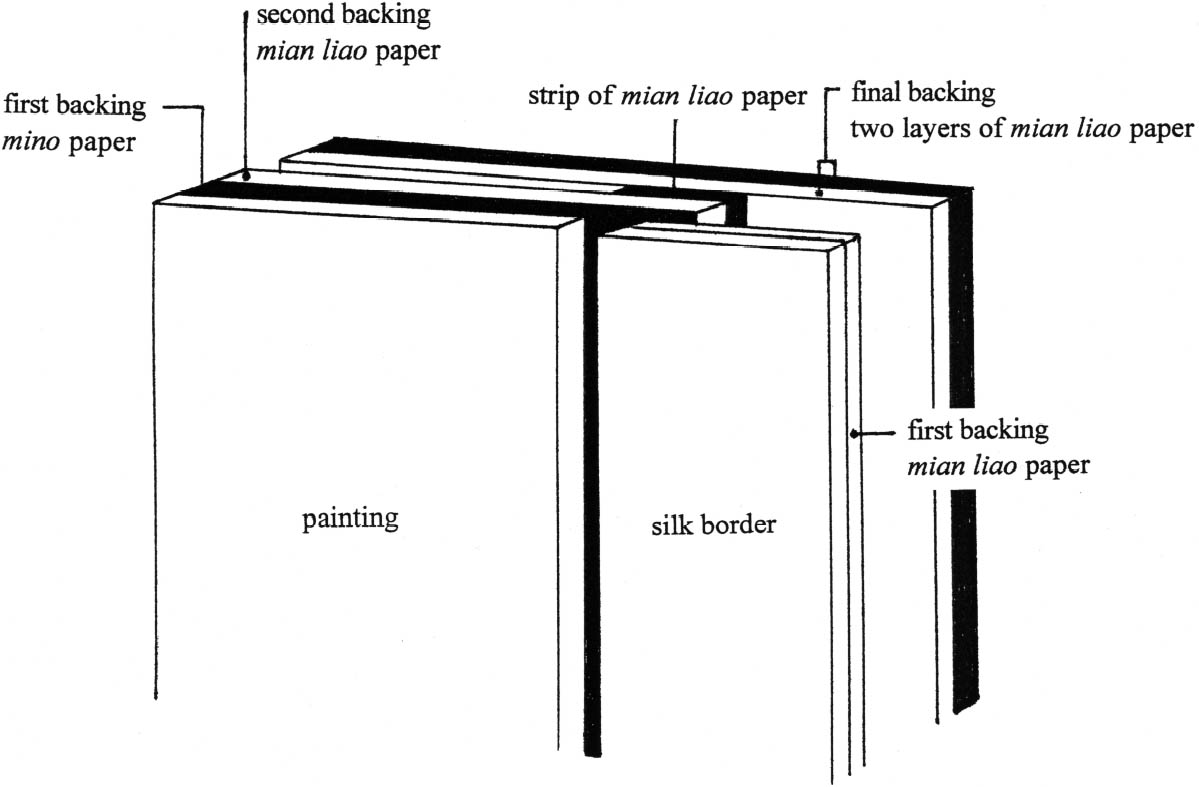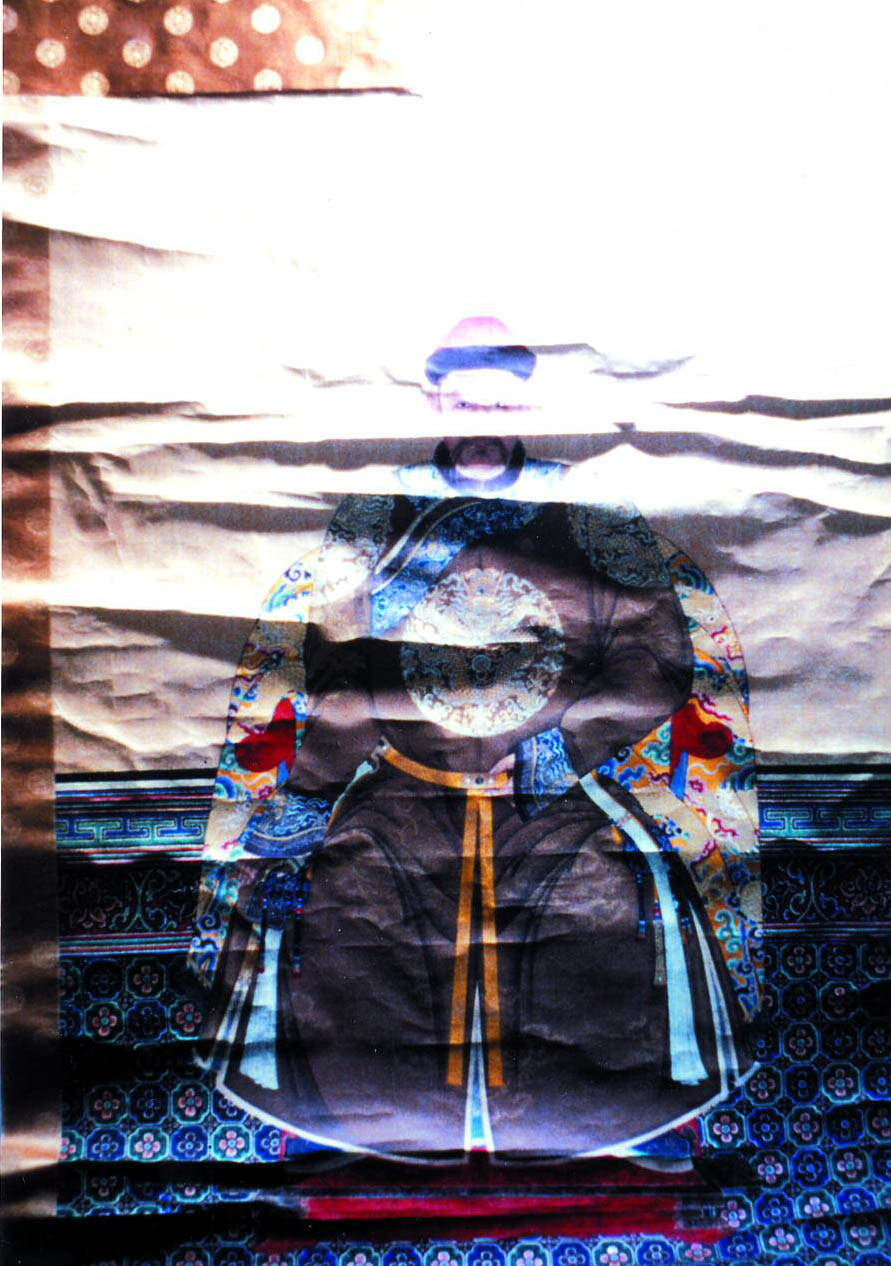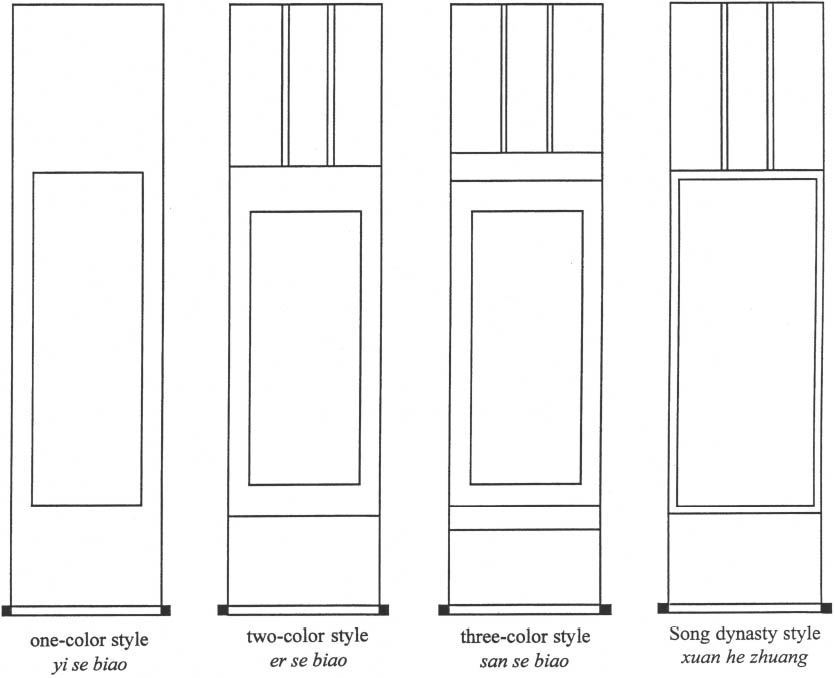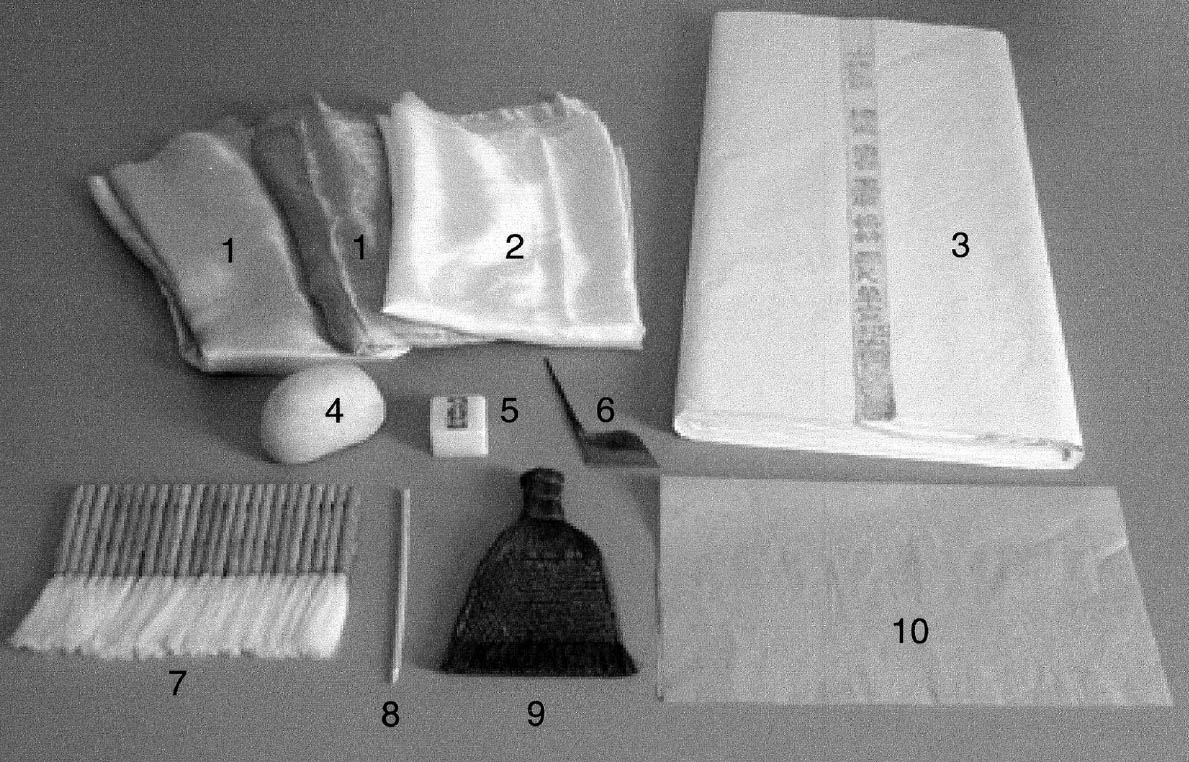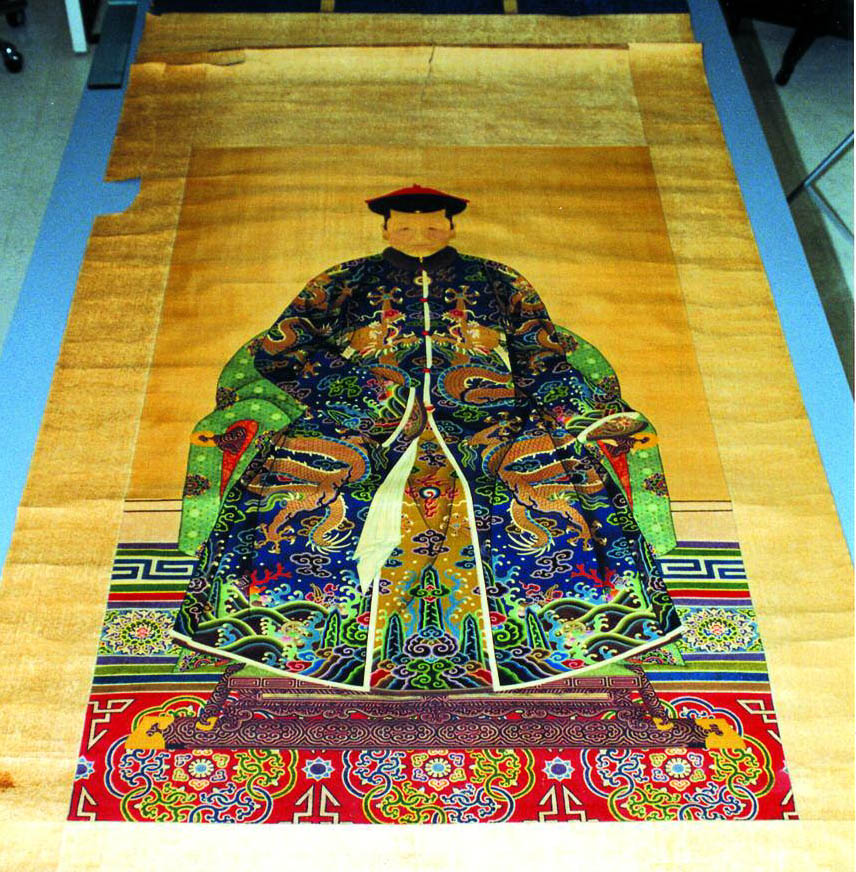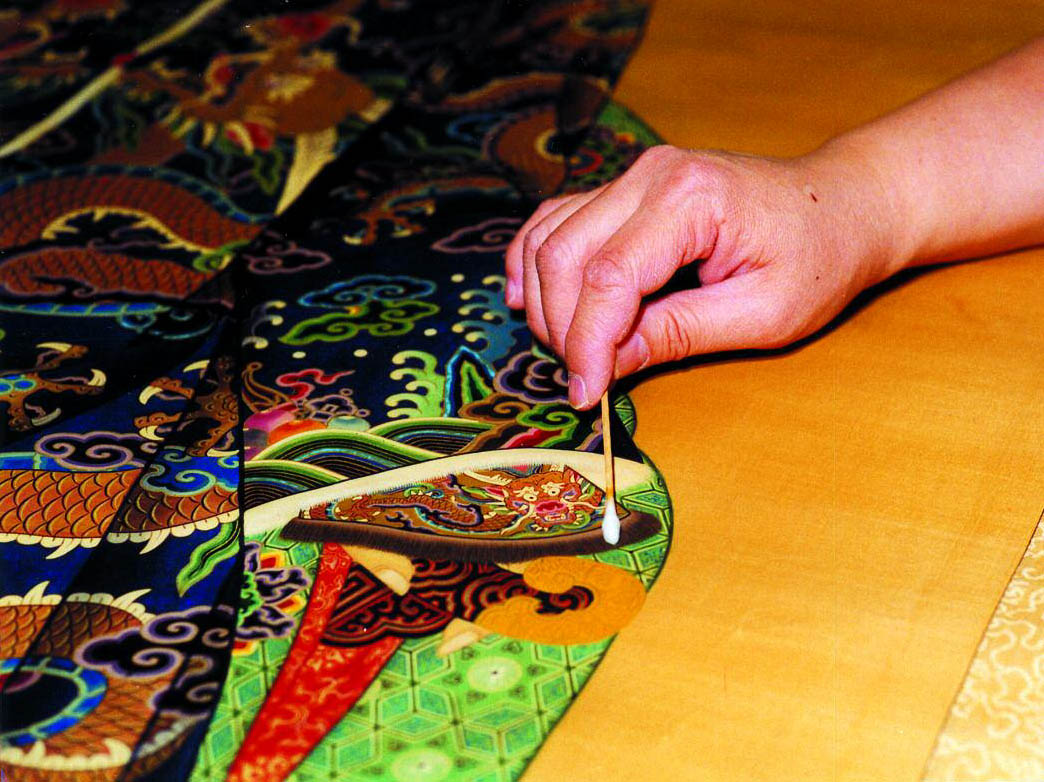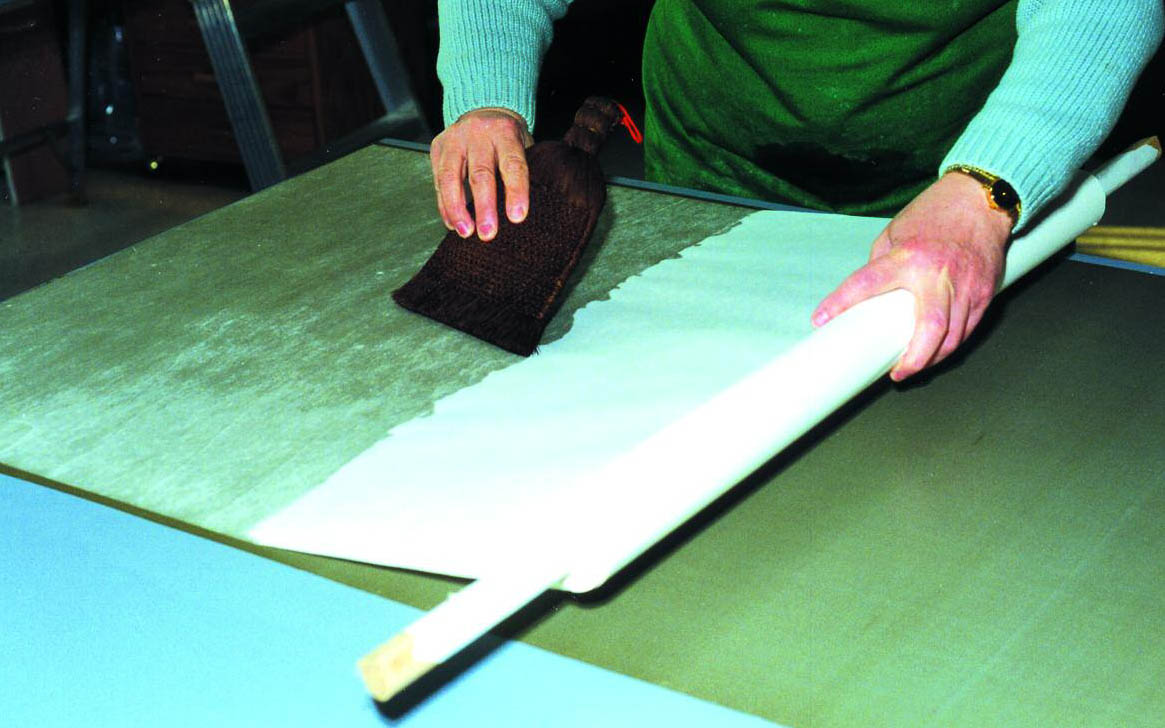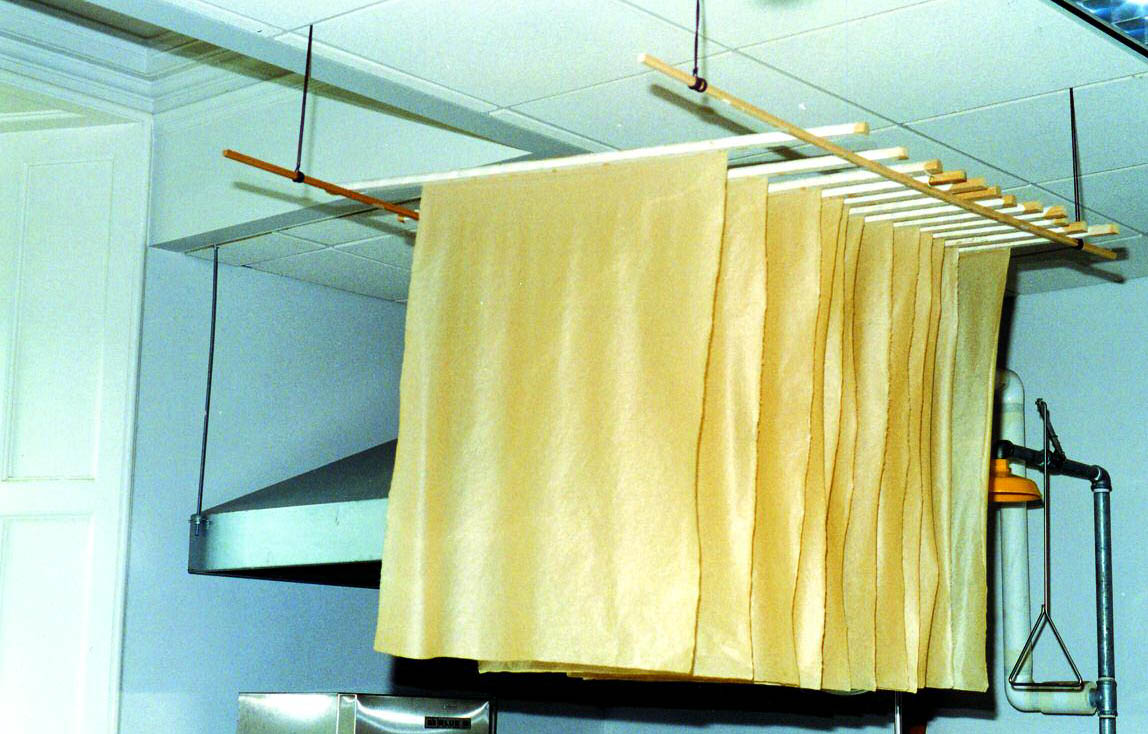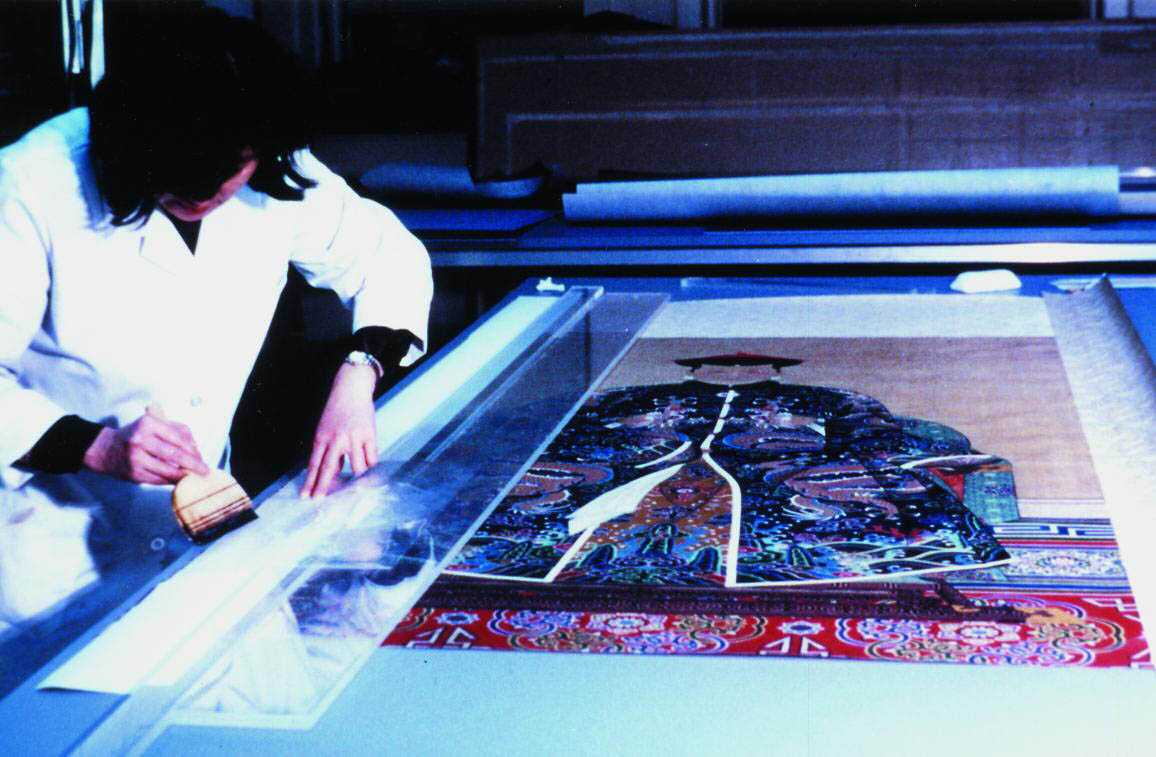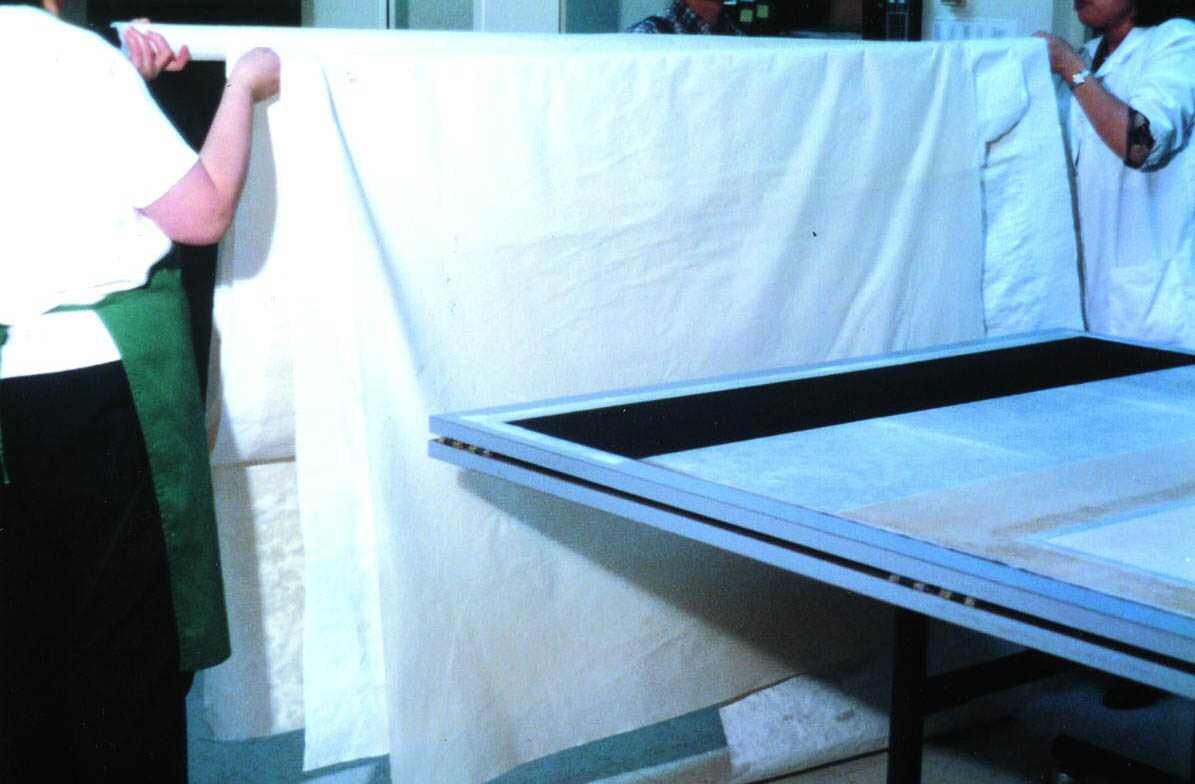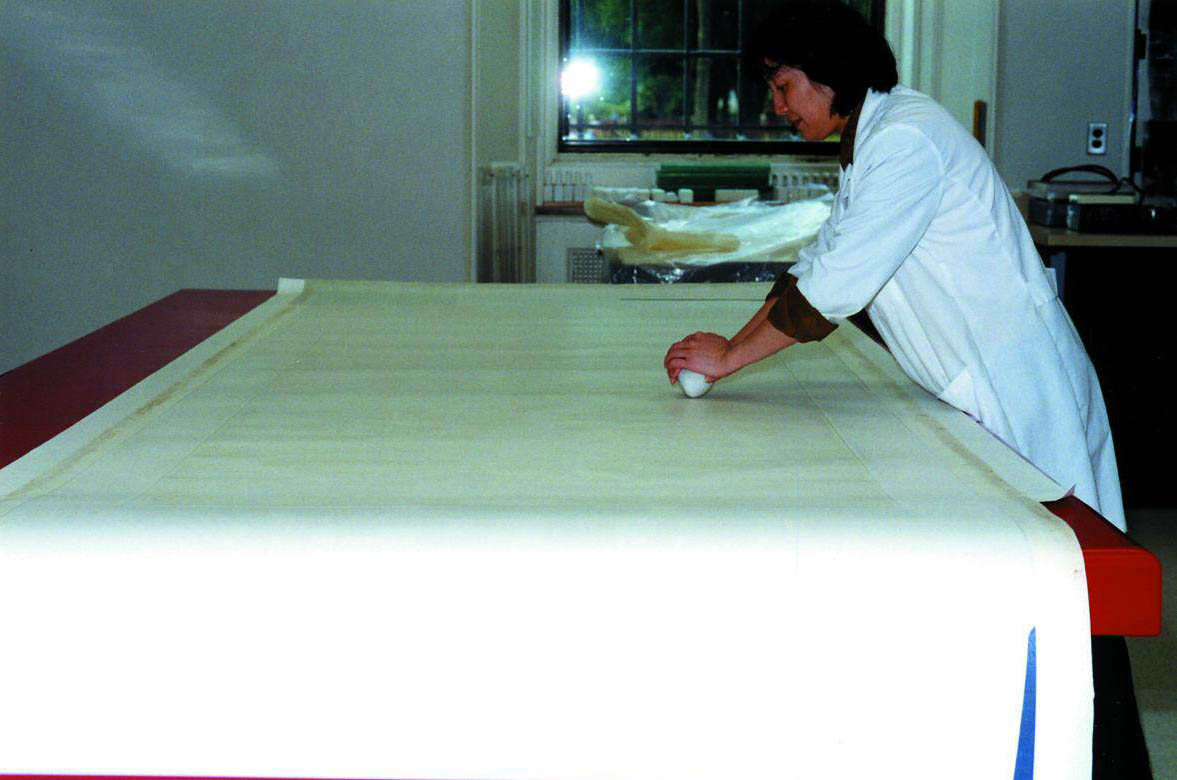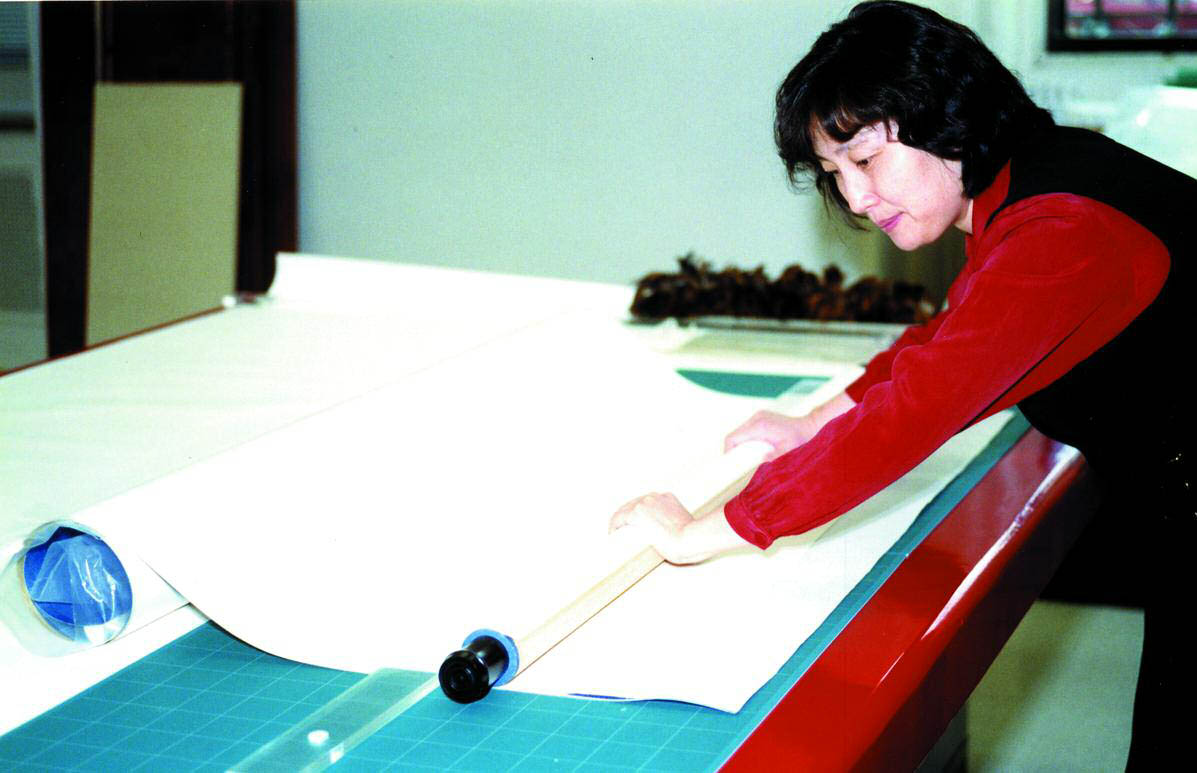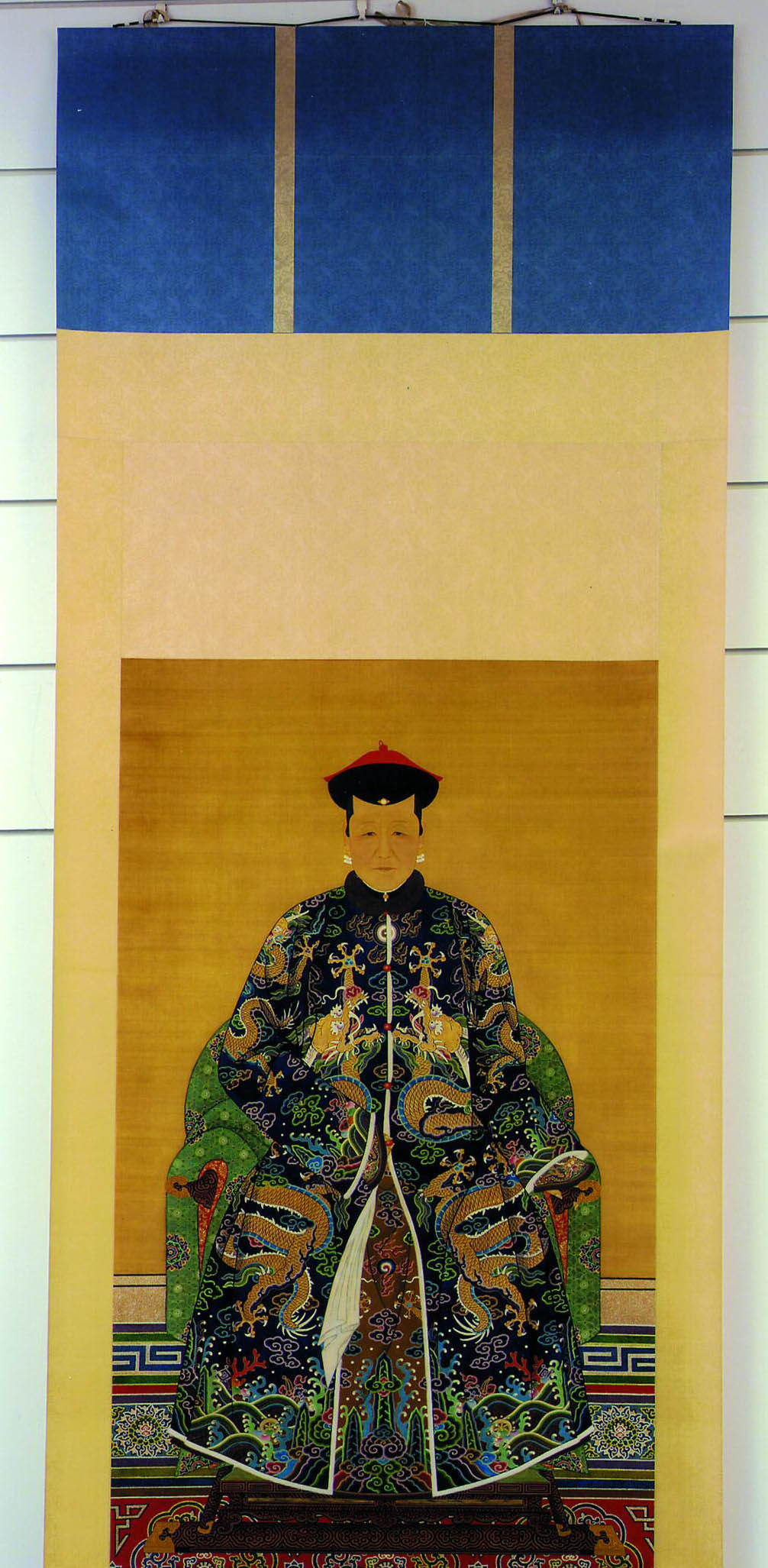THE TREATMENT OF CHINESE ANCESTOR PORTRAITS: AN INTRODUCTION TO CHINESE PAINTING CONSERVATION TECHNIQUESVALERIE LEE, XIANGMEI GU, & YUAN-LI HOU
ABSTRACT—In 1991, the Arthur M. Sackler Gallery, Smithsonian Institution, acquired a collection of 83 Chinese ancestor portraits in the format of hanging scrolls. The museum decided to make 34 of the scrolls the subject of an exhibition called Worshiping the Ancestors: Chinese Commemorative Portraits, which opened in the summer of 2001. The condition of the paintings was evaluated, and it was determined that some paintings required a complete remounting while others required minimal stabilization. In this article, some specifics of Chinese painting conservation will be discussed, and a complete remounting process will be thoroughly described. It is our hope that this article will provide a better understanding of Chinese painting conservation while making its techniques more familiar to Western conservators. TITRE—Le traitement des portraits d'anc�tres Chinois: introduction aux techniques chinoises de restauration des peintures. R�SUM�—En 1991, la Arthur M. Sackler Gallery (Mus�e d'art Arthur M. Sackler) a fait l'acquisition d'une collection de 83 portraits d'anc�tres Chinois mont�s sur rouleaux. Trente-quatre de ces portraits ont �t� pr�sent�s durant l'�t� 2001 lors d'une exposition intitul�e Worshiping the Ancestors: Chinese Commemorative Portraits (Le culte des anc�tres: portraits comm�moratifs de Chine). L'�valuation de l'�tat de conservation des peintures en vue de l'exposition a permis d'�tablir que certaines requ�raient un remontage complet alors que d'autres ne n�cessitaient qu'un traitement minimal de stabilisation. Dans cet article, certains aspects sp�cifiques aux techniques chinoises de restauration des peintures sont pr�sent�s, et un proc�d� de remontage est d�crit �tape par �tape. En rendant ces techniques plus famili�res aux restaurateurs occidentaux, les auteurs esp�rent contribuer � une meilleure compr�hension de la restauration des peintures telle qu'elle est effectu�e en Chine. TITULO—Tratamiento de retratos chinos de ancestros: una introducci�n a las t�cnicas chinas de conservaci�n de pinturas. RESUMEN—En 1991 la Arthur M. Sackler Gallery (Galer�a Arthur M. Sackler) adquiri� una colecci�n de 83 retratos chinos de ancestros en formato de rollos colgantes. El museo decidi� hacer una exposici�n con 34 de estos rollos que se llam� Venerando a los Ancestros: Retratos Chinos Conmemorativos que fue inaugurada en el verano del 2001. Luego de evaluar la condici�n de las pinturas se determin� que algunas requer�an un montaje completo nuevo, mientras que otras requer�an una m�nima estabilizaci�n. En este art�culo se discuten algunos aspectos espec�ficos de la conservaci�n china de pinturas y se describe en detalle un proceso de montaje completo. Esperamos que este art�culo proporcione un entendimiento mejor sobre la conservaci�n china de pinturas y que familiarice a los conservadores occidentales con estas t�cnicas. T�TULO—O tratamento de retratos de ancestrais chineses: introdu��o �s t�cnicas de conserva��o de pinturas chinesas. RESUMO—Em 1991, a Arthur M. Sackler Gallery (Galeria Arthur M. Sackler) adquiriu uma cole��o de 83 retratos de ancestrais chineses em formato hanging scroll (obra oriental em forma de rolo). Dentre eles, 34 foram escolhidos para a exposi��o Culto aos Antepassados: Retratos Chineses Comemorativos, que aconteceu no ver�o de 2001. Ap�s avalia��o das condi��es f�sicas das pinturas determinou-se que algumas precisavam ser remontadas completamente, e outras necessitavam apenas de estabiliza��o m�nima. O presente artigo discute quest�es relativas � conserva��o de pinturas chineses, detalhando especificamente o processo de remontagem. Esperamos assim, oferecer um melhor entendimento sobre t�cnicas de conserva��o de pinturas chinesas, tornando-as mais familiar aos conservadores do Ocidente. 1 INTRODUCTIONIn 1991, the Arthur M. Sackler Gallery, Smithsonian Institution, in Washington, D.C., acquired a collection of 83 hanging scrolls, which were portraits from the Of the 34 paintings, 32 were executed on silk supports, one on paper, and one on cotton. Pigment analysis conducted by the museum's scientists revealed that mineral pigments, such as malachite, azurite, orpiment, and vermilion, were used in several paintings. The binder was found to be animal glue, and a high pigment-to-binder ratio gave the paints a soft, matte appearance. Thick layers of paint, up to 1 mm thick on some paintings, were typically applied in the costume area, while thin washes were applied on the face and hands. We also observed that azurite and malachite were ground to different degrees on the same painting. These differences allowed the artist to use a greater range of colors, as pigments appear darker when coarsely ground and lighter when more finely ground (Winter 1985). The details of the costume were often quite beautiful, meticulously depicting embroidery and jewelry. Great care was taken with the costume because it revealed the rank of the deceased. The paintings were previously mounted with silk borders in the tradition of Chinese hanging scrolls (figs. 1, 2). This format came to be popular for Chinese paintings during the 11th century A.D. (Gulik [1958] 1981) and was commonly used for ancestor portraits. The paintings and silks were separately backed with one or two paper layers, depending on the thickness of the painting, and then joined together. The entire unit was supported with two or three additional paper layers. Two narrow vertical silk strips were pasted onto the upper border of the scroll for decoration. A semicylindrical hanging rod was attached to the upper edge of the scroll so that it could be hung on the wall for viewing purposes. A cylindrical roller was attached to the lower edge of the scroll so that its weight enabled the scroll to hang straight when it was suspended on the wall. The painting could also be rolled around the roller for storage, and two knobs, previously attached to each end of the roller, eased this process. Rolling paintings was an efficient way of saving space for storage, as paintings were only shown and appreciated for a short period of time. Ancestor portraits, for example, were mainly displayed during the Chinese New Year and occasionally during special events such as birth-days (Stuart and Rawksi 2001).
Upon closer examination, we discovered that most of the paintings had dust and stains, most likely due to inappropriate storage. Poor handling and rolling of the thick paint layers had also caused creases and tears (fig. 3, see page 452). Some portraits had extensive pigment loss and flaking. The azurite and malachite were particularly damaged because they were applied in thicker layers and therefore were more vulnerable to abrasion. Many scrolls were also brittle, weak, and dirty. As a result, 14 paintings had to be remounted before being presented to the public. This task proved challenging for two reasons: the large scale of the paintings (most measure 300 cm � 120 cm) and the sensitivity of the colors to water. The remaining 20 paintings were able to undergo minor treatments such as reinforcing creases and tears, removing stains, flattening, and inpainting. In this article, we will first present Chinese painting conservation objectives and describe some of the traditional tools we use. We will then describe the remounting process used in our treatment of one of the ancestor portraits.
2 OBJECTIVES AND MATERIALS OF CHINESE PAINTING CONSERVATIONChinese mounting and conservation techniques are Hanging scrolls are very complex objects, as they are made with several types of materials (silk, paper, and wood), which all react differently to climatic changes. It is a real challenge to obtain a perfect hanging scroll, and the techniques used by conservators should be particularly precise so that scrolls can function properly. Because the painting and the scroll are structurally joined, defects in scrolls can ultimately One interesting aspect of the East Asian painting conservation studio is that conservators of both Chinese and Japanese paintings work in the same space. This arrangement allows for a wonderful exchange of ideas and techniques, and, as you will read in this article, we used some Japanese papers and brushes when we thought they would provide better results. However, it should be emphasized that Japanese and Chinese mounting techniques are different in many regards, partially due to the nature of the materials used. For example, Chinese paper has shorter fibers than Japanese kozo paper and is difficult to handle when wet. However, its ability to attach to another Chinese paper is quite remarkable. As a result, very little paste is used for backing, giving great flexibility to scrolls. Our studio always uses the finest quality of xuan papers from the Anhui province (fig. 5), which is made from the bast fibers of pteroceltis tatarinowii maxim trees (also called blue sandalwood), mixed with rice straw (Tsai and Van der Reyden 1997). Papers come in different sizes (approximately 70 cm � 140 cm or 80 cm � 150 cm or 100 cm � 180 cm) and thicknesses (ranging from 0.25 mm to 0.8 mm). There are two different grades, depending on the percentages of blue sandalwood and rice straw used. They can be translated as pure or fine bark (jing pi) and cottonlike (mian liao). The mian liao papers are more flexible than the jing pi and are usually preferred for mounting scrolls. Xuan papers have an alkaline pH due to residual lime or wood ash used in the steaming
Two types of silk are used for Chinese scrolls at the East Asian painting conservation studio. One is unpatterned “china” silk (geng juan), which has a warp-predominant plain weave structure and is approximately 85 cm wide. The other one is a patterned silk (hua ling juan), which has a warp-predominant twill damask structure and is approximately 70 cm wide1 (see fig. 5). The patterns are currently quite limited and come as birds, flowers, or bamboo. Some studies are presently being conducted in Japan and China to reproduce old mounting silks in order to create a greater choice of fabrics. Mounting silks are available in a wide range of colors and can also be dyed by conservators. The low count of warp and weft of these silks results in very elastic fabrics, which require a great deal of experience to work with them. We use wheat starch paste (xiao fen jiang) as our main adhesive for scroll mounting, and we cook it for 45 minutes on a stove at a concentration of approximately 13% (dry weight to water). We sieve the paste through a horsehair sieve and thoroughly blend it in a bowl with a Japanese joining brush. We then add water to obtain the consistency needed. In this article, we will describe three different paste consistencies. To simplify the discussion, we will call the first one “thick consistency paste.” It is a strained paste that has a small amount of water added, and its consistency could be described as custardlike. The second one, or “medium consistency paste” could be compared to yogurt. The last one, “thin consistency paste,” is very similar to the consistency of milk. Two
3 EXAMPLE OF A REMOUNTING3.1 CONDITION BEFORE TREATMENTThe portrait in figure 6 (see page 452) represents Lirongbao's wife, Emperor Qianlong's mother-in-law. This emperor ruled between 1736 and 1795, but it is uncertain that the portrait is from this time. It
3.2 TREATMENT OPTIONSBefore we began the conservation process, treatment options were discussed with the curator of the collection. Though it is our goal to preserve, whenever possible, original scrolls, in this case it was necessary to remount the painting. This particular scroll was too weak to support the painting. Keeping it, even with some repairs, ultimately could have led to more damages to the painting. Original silk borders could not be reused as they were too physically deteriorated. Since the existing scroll was harmonious with the painting, we decided to replicate its style, including the scroll dimensions and colors of silk borders. 3.3 PREPARATION OF THE PAINTINGSolubility of the pigments was first tested by gently rolling a slightly dampened cotton swab over their surface, gradually exposing the pigments to moisture for a prolonged period of time. All colors proved to be sensitive under moisture and therefore needed to be fixed because a large amount of water would be introduced during the backing paper removal and mounting process. However, the painting was dusty, and we were concerned that the dust would be trapped in the pigments by the fixative. Therefore, we carefully rolled a slightly dampened cotton swab over their surface, keeping the contact minimum, and were successful at removing the dirt without any danger to the color (fig. 7, see page 453).
Although animal glue is traditionally used as a fixative by Chinese painting conservators, we felt that isinglass would prove to be a better option since it had a lower viscosity and a greater tack, therefore requiring less use (Petukhova and Bonadies 1993). It also possessed a less yellowish color than animal glue. A 1% (dry weight to water) concentration of isinglass was prepared. This concentration had desirable working properties, as it did not saturate the pigment. Traditionally, a fixative would be applied with a Chinese inpainting brush (see fig. 5). However, we felt that an application with an airbrush would reduce the size of the drops, therefore permitting better penetration and an even distribution through the paint surface. Every pigment was tested, and no evident color shift developed. The 1% warm isinglass solution was then applied with an airbrush by working in areas approximately 20 cm � 20 cm throughout the entire painting. Once the painting had dried for a period of one day, the pigments were tested for water sensitivity with a dampened cotton swab, as described earlier. The pigments were still sensitive to water. Isinglass was applied a second time over the entire painting and left to dry for another 24 hours. A third test did not show any water solubility. The old silk borders were cut off, and samples were preserved for the records. 3.4 PREPARATION OF THE SILK BORDERSSilks for the borders were selected to closely resemble the original scroll. One piece of silk was chosen for the two decorative strips or jing yan that would be pasted on the upper middle border of the scroll (see fig. 1). The type of silk used for the strips was similar to the upper border, yet its color was similar to the middle border. Another piece of silk was selected to be used as a cover when the scroll was rolled closed (see fig. 1). The silks were backed with one layer of mian liao paper to enable them to be joined to the painting later. Initially, backing papers were chosen and squared. Silks were cut to the appropriate
To make the color more compatible with the painting, the silks were toned with pigments bound with animal glue that were purchased in China. They were in the shape of small solid pans, which were then dissolved in warm water and diluted to the desired concentration to tone the silk. The pigments used were indigo, earth, gamboge, and traditional Chinese ink sticks. The first pigment mixture was tested on pieces of backed silk, and the tone was adjusted appropriately until the desired tone was achieved. The color was sieved through rayon paper to remove large particles of pigment. The silk was put paper side up on the table, and the pigment mixture was applied with a water brush. The silk was then turned over and flattened with the same brush without applying more of the pigment mixture. More pigment was added locally as necessary to areas that did not seem to be homogeneous. The silk was then stapled to a wooden stick and hung to air-dry. The following day, the silks were misted with water and placed facedown on the table, and 3% methyl cellulose (dry weight to water) was applied to their outer edges. They were then attached faceup on drying boards and left there until the painting was ready to receive them. 3.5 TONING THE PAPER FOR THE FIRST BACKINGThe ancestor portraits were painted on an open-weave silk support, enabling the color of the first backing paper to be visible from the front of the painting and therefore strongly influence the appearance of the painting. The original first backing as well as the other subsidiary linings of the painting were very brownish in color and gave the unpleasant impression that the painting was yellow. From experience, we knew that a lighter-toned first backing would allow the painting to look more fresh. We chose to use Japanese mino paper for the first backing because it has longer fibers and therefore is stronger than Chinese paper. Silk can tear easily on a drying board because it tends to expand dramatically with moisture and shrink subsequently as it dries. This process is particularly dangerous for large-scale paintings, as reactions to moisture are more difficult to control. However, we chose to use mian liao papers for the second and final backings to uphold the tradition of Chinese hanging scrolls. We tested several pigment mixtures on pieces of mino paper to arrive at the desired tone. Sheets of mino paper were then rolled around a wooden rod. The pigment mixture was brushed with a water brush directly onto the table, and the first paper was laid down. As the paper absorbed moisture and began to expand and undulate, it was gently lifted from the table and brushed flat with the smoothing brush. More pigment mixture was applied with the water brush to the paper, and a second sheet of paper was gradually unrolled atop it, using the left hand, and brushed down with the right hand. This step required good coordination of the hands, as the paper could easily break if pulled too strongly by the left hand or if the angle between the two sheets was too high. The second sheet was then lifted and repositioned so that it was accurately aligned with the first sheet. It, too, was then brushed flat. The remaining sheets were toned using the same process. Because the papers were toned on top of each other, the pigment mixture was distributed evenly. Once all the papers were toned, they were attached one by one with methyl cellulose to wooden sticks on one side and hung to air-dry (fig. 9, see page 453).
3.6 REMOVING THE OLD BACKINGA piece of rayon paper 20 cm wider and longer than the painting was brushed flat onto the table using
3.7 APPLYING THE FIRST AND SECOND BACKINGPieces of previously toned mino paper were chosen and squared with feather-cut edges. Because they were shorter than the painting in width, smaller sides of each sheet were joined along their feather-cut edges with thin paste to form a roll of paper. Sheets were cut from the roll so that they were 10 cm wider than the painting. Because the mino paper sheets were quite large, a slightly bigger sheet of rayon paper was cut to handle them safely. One sheet of mino paper at a time was placed on the rayon paper, and a thick consistency paste was applied to it. Excess moisture was removed from the mino paper by placing the rayon paper with the mino paper on top of two layers of dry Chinese paper. The mino paper and the carrier were then lifted up and turned over above the painting and aligned. One edge of the paste-coated mino paper was placed down and aligned so that it extended from the sides of the painting by 5 cm, and the remaining backing was gradually brushed in contact with the painting using a smoothing brush. Additional backing papers were applied in the same manner down the length of the painting to form a complete layer. The overlap of the joins between the backing papers was made as minimal as possible so they would not be seen from the painting's face. The backing paper was then brushed more aggressively overall, using a sheet of paper impregnated with paulownia as a protection, to ensure good contact with the painting. The painting was then separated from the table for a brief moment to allow some air to circulate and left to dry on the table for one day. Thin mian liao papers, 3 mm wide, were cut with straight edges and used to reinforce the painting's tears and creases. The painting was placed facedown on the table, misted with water, and brushed flat. Strips were coated with medium consistency paste, adhered over the center of the crease, and pounded with the smoothing brush. They were left to dry for one day. A second backing of a traditional mian liao paper, 10 cm wider than the painting, was applied. The painting was placed facedown on the table, misted with water, and brushed flat on the table. The smooth sides of the papers were pasted, one at a time, with thin consistency paste on a piece of rayon paper, and the backing was applied as described above for the first backing. To compensate for the thickness of the painting and to strengthen the outer edges, 5 cm wide strips of mian liao paper were adhered with thin consistency paste to the outer edges of the backing papers. The strips also overlapped the painting by 3 mm (see fig. 2). The painting was separated from the table and left to dry on the table for one day. 3.8 TEMPORARY BACKINGThe painting needed to be quite flat in order to attach the silk borders. But restrained drying on a drying board is a particularly dangerous step for silk paintings due to their great capacity for expansion and contraction, which can cause tears during the drying period. For this reason, a temporary backing was attached to the painting in order to provide extra strength during the drying process. The temporary backing was prepared by pasting two layers of jing pi paper together with a thin consistency paste and then
3.9 ATTACHING THE SILK BORDERSThe thicknesses of the backed silk borders and the backed painting were examined to ensure that they were equal. The outer edges of the backing were trimmed 5 mm so that they would lie straight, and the silk borders were trimmed according to the scroll measurements determined previously. The painting was placed faceup on the table, and thick consistency paste was applied to a 3 mm wide area along its outer edges. The inscription and the middle border were then attached to it. The outer edges of the inscription and middle border were then pasted as described earlier (fig. 12, see page 454), and the upper and lower borders were attached to them.
After attaching the silk borders to the painting, the outer edges of the scroll were folded inward to provide a clean look and reinforce the scroll. The scroll was loosely rolled, and a needle was inserted 3 mm from the outer edges of the backing, through the several rolled layers, to mark the measurement along the length of the scroll. This efficient method enables us to make repeated markings along the length of the painting. The scroll was placed facedown on the table, and a ruler was positioned along the needle holes. A line was impressed into the backing paper by running the needle at an angle along the ruler to create a crease. Medium consistency paste was applied with a Japanese joining brush along the newly formed crease, and the outside edges were folded over by brushing them toward the scroll with a smoothing brush. At this stage, pockets were created for the attachment of the hanging rod and roller to the scroll. Two strips of mian liao paper were cut slightly wider than the mounting and longer in length than the diameter of the rods. The strips were pasted with thick consistency paste along one width's edge and attached to the verso of the scroll, one 5 cm from the top edge and the other 8 cm from the bottom edge. 3.10 FINAL BACKING PAPERA final backing, consisting of two layers of three mian liao papers each, was applied to support the mounting assembly and the painting (fig. 13). The first layer was prepared by squaring three sheets of mian liao and cutting them 10 cm wider than the scroll. The three sheets were placed on the table and misted with water. Thin consistency paste was evenly applied all over one sheet with the water brush, carefully avoiding creasing the paper. A second sheet was misted with water and joined 3 mm onto the first one. The join
The scroll was placed facedown on the table and was relaxed by lightly misting water over all of it. A wetted ball of paper was rolled along the joins of the borders to ensure that they were thoroughly relaxed. Another piece of backed silk, 30 cm long and 10 cm wider than the scroll, was attached with thin consistency paste to the top of the verso of the mount to be used as a cover when the scroll was rolled closed. On another table, the backing paper was misted with water and lightly brushed flat, and thin consistency paste was generously applied with a water brush. The excess moisture was removed by placing sheets of dry Chinese paper under the backing. Because the backing paper was very large (350 cm by 150 cm), it was carried along with the drying paper on two wooden sticks, adhesive side facing up (fig. 14, see page 455). The pasted side of the backing paper was placed in contact with the scroll, and the drying paper was then removed. The top edge of the backing paper was aligned along the bottom edge of the silk cover, overlapping by 3 mm, and then placed down onto the rest of the scroll and brushed with a smoothing brush. The brushing of the backing was essential in the mounting process. The backing had to be well attached to avoid future detachment and formation of creases. The consistency and amount of paste were also critical: if it was too thick, the scroll would become stiff, and if it was too thin, the backing would not attach. The scroll was lifted from the table and brushed a second time. It was then turned faceup, and two strips of silk called jing yan were pasted with medium consistency paste onto its upper border. The scroll was turned one last time on the table, and a piece of paper on which the title of the painting would traditionally have been written was pasted with medium consistency paste and attached to the upper-right edge of the cover (see fig. 1). Two rein-forcing pieces of backed silk or da gan were pasted vertically along each lower edge of the scroll to help with the weight of the roller (see fig. 1). The pockets were held down in place temporarily with spots of medium consistency paste to prevent them from distorting. The scroll was brushed strongly overall with the smoothing brush, separated for a brief moment from the table, and left to dry overnight on the table.
The following day, the scroll was rehumidified and flattened with a smoothing brush. The 5 cm wide 3.11 FINAL STEPSThe back of the scroll was then rubbed overall with a stone to enable the scroll to be rolled easily and to minimize abrasion to the surface of the painting as the scroll is rolled (fig. 15, see page 455). A package consisting of three layers of xuan paper adhered together with wheat starch paste was placed on the table, and the painting was placed upon it. The backing was lightly rubbed overall with paraffin wax to facilitate the rubbing action of the stone. The stone was then pushed back and forth across the width of the scroll to obtain a smooth and evenly polished surface. Caution was taken throughout this entire process to avoid pigment loss through the application of pressure. The outside edges of the backings were folded 1 mm inside the scroll to provide a clean look and cut along the fold with the horseshoe knife.
To complete the scroll, wooden rods were attached to the top and bottom of the scroll. The quality of the wood was important because, when stored, the mounted painting would be rolled around the rods. If the wood was highly resinous, the resin could migrate through the scroll and into the painting, causing stains. Also the wood could not be too dense because too much weight at the bottom could cause the scroll to tear. Therefore, we chose to custom-make rods from paulownia wood because they were light weight and not very resinous. The roller, which was 5 cm in diameter, was cut at one end, leaving a central core 1 cm wide to be fashioned later into an end peg. The peg was shaped with a knife to fit into the hole of the knob. Knobs, previously bought in China, were selected to closely match the original ones that were in too poor a condition to be reused. Chinese knobs are traditionally around 5 mm smaller in diameter than the roller. The scroll was placed facedown on the table, and the pocket was opened with a bamboo spatula. The roller was then placed in the pocket, and the position of the silk border was marked on the roller with a needle. The other end of the rod was fashioned as previously described. To prevent the roller from being exposed at the point where it joins the knobs, both ends were covered with the same backed silk used for the lower border. The knobs were attached to the peg. The pocket was folded back, and a strip of Mylar was placed underneath it to protect the scroll. A 2 cm wide area of thick consistency paste was applied to the bottom edge of the pocket. The roller, fitted with knobs, was placed along the hinge, extending onto the pocket. It was critical to position the roller perfectly parallel to the hinge so that it could function properly. It was then rolled back to the paste line, attaching the pocket to the roller (fig. 16, see page 455). At that point, a line of thick consistency paste was applied along the hinge and along the bottom edge of the silk border. The roller was rolled to the hinge, secured in place with one hand, and the entire scroll was turned over so it was faceup. Because the scroll was wide, two conservators were needed for this step. The silk border was then attached to the roller and left to air-dry. Conservators of Chinese paintings believe that this step is one of the most important in the mounting process because it is difficult to remove the roller after it has been attached and because it must be perfectly parallel to the scroll to ensure that the painting is not damaged when rolled.
A semicylindrical piece of paulownia 2 cm in diameter was used for the hanging rod. Four hanging scroll nail eyes were screwed along the hanging rod to later receive the hanger braid. The length of the hanging rod was calculated in the same manner as the roller, and both ends were covered with the same backed silk used for the cover of the scroll. The scroll
4 CONCLUSIONSThis article presents an overview of Chinese mounting techniques for hanging scrolls. However, diverse formats are used for Chinese paintings on silk or paper. They include hanging scrolls, hand scrolls, albums, panels, and fans, and each requires a specific mounting technique. Therefore, conservators of Chinese painting must acquire extensive experience in the field to build their knowledge of mounting formats. It is our objective to carefully balance the craft and introduce new materials. We hope that readers will find some of our methods and techniques useful in the conservation of Western art and that more exchanges between these two fields will occur in the future. NOTES1. Both textiles had been hand-dyed before being examined by Christine Giuntini, consulting textile conservator.Unpatterned silk (geng juan), warp predominant, plain weave (tabby). Counts: warp: −50 ends/cm; weft: −37 picks/cm; selvage: .5 cm width; no change in structure.Patterned silk (hua ling juan), 3/1 Ztwill damask, warp predominant. The weft face forms the pattern. Counts: warp: −50–52 ends/cm; weft: −30–31 picks/cm; selvage: .7 cm width composed of 20 ends woven in plain weave (tabby). ACKNOWLEDGEMENTSWe would like to acknowledge the Fidelity Foundation's generous support of this two-year project. We are extremely grateful to the staff of the Freer and Sackler Galleries, especially Paul Jett, Jane Stuart, Andrew Hare, Jiro Ueda, and Akihiro Kato, and to John Winter, who provided insights on Chinese pigments, and Jai REFERENCESAcker, W. R. B.1954. Some T'ang and pre-T'ang texts on Chinese painting. Leiden: E. J. Brill. Gulik, R. H. V.[1958] 1981. Chinese pictorial art as viewed by the connoisseur. Reprint, New York: Hacker Art Books. Petukhova, T., and S. D.Bonadies. 1993. Sturgeon glue for painting consolidation in Russia.Journal of the American Institute for Conservation32:23–31. Stuart, J., and E. S.Rawski. 2001. Worshiping the ancestors: Chinese commemorative portraits. Washington, D. C.: Smithsonian Institution. Tsai, F. W., and D.Van der Reyden. 1997. Analysis of modern Chinese paper and treatment of a Chinese woodblock print.Paper Conservator21:48–62. Wills, P.1987. New directions of the ancient kind: Conservation traditions in the Far East.The Paper Conservator11:36–38. Winter, J.1985. Some material points in the care of East Asian paintings.International Journal of Museum Management and Curatorship4:251–64. FURTHER READINGHunter, D.1957. Papermaking: The history and technique of an ancient craft. New York: Alfred A. Knopf. Illouz, C.1998. Conservation des peintures en Chine et au Japon: Differences techniques et culturelles.Conservation Restauration des Biens Culturels12:9–13. Landwehr, U.2002. Chinesische h�ngerollbilder: Montagetechnik und typische Schadensph�nomene.Restauratorenbl�tter22:69–79. Lin, H.1999. Restauration de peintures et calligraphies chinoises anciennes, trans. C. Thouvenin.Conservation Restauration des Biens Culturels13:3–6. Mullock, H.1995. Xuan paper. Paper Conservator19:23–29 Petukhova, T.1989. Potential applications of isinglass adhesive for paper conservation.Book and Paper Group Annual8:58–61. Stuart, J.1997. Calling back the ancestor's shadow: Chinese ritual and commemorative portraits. Oriental Art63(3):8–17. Winter, J.1984. Natural adhesives in East Asian paintings. In Adhesives and consolidants, ed.N. S.Brommelle et al. London: International Institute for Conservation of Historic and Artistic Works. 117–120. Winter, J.1984. Pigments in China: A preliminary bibliography of identifications. ICOM Committee for Conservation preprints, 7th Triennal Meeting, Copenhagen. Paris: ICOM. 84. 19. 11–12. Winter, J.1985. Paints and supports in Far Eastern pictorial art. Paper Conservator9:24–31 SOURCES OF MATERIALSKnobs, pigments, Red Star xuan papers, stone, unpatterned and patterned silks for mounts, water brush, and smoothing brushMan Luen Choon 29-35 Wing Kut St. 2/F Harvest Building Hong Kong People's Republic of China Talas 568 Broadway New York, N.Y. 10012 Mino paper, Hasegawa production, thin, 2.5 mome weight; paraffin wax (ibota); rayon paper, unwoven fabric type (fushokufu), thick/heavy weight (atsukuchi)Nemoto Corporation 2-6-17 Tagara, Nerima-ku Tokyo 179-0073 Japan AUTHOR INFORMATIONVALERIE LEE received a B.A. in art history at the University of Paris 1 and an M.A. in paper conservation in 1996 from the Institut de Formation des Restaurateurs d'Oeuvres d'Art (ENP-IFROA) in Paris. She came to the Freer and Sackler Galleries to learn Chinese paintings conservation in 1996 with funding from the Kress Foundation and the Lavoisier Foundation. She is continuing her work there as an assistant conservator in East Asian paintings. Address: Freer Gallery of Art and Arthur M. Sackler Gallery, Smithsonian Institution, Washington, D.C., 20560-0707 XIANGMEI GU was trained in 1972 at the Shanghai Museum, China, where she worked as a painting conservator until 1987. She worked at the Art Institute of Chicago from 1987 to 1988. She has been an East Asian paintings conservator at the Freer and Sackler Galleries since 1990. Address as for Lee. YUAN-LI HOU was trained in 1975 at the Beijing Palace Museum, China, where she worked as a painting conservator until 1986. She joined the staff at the Freer and Sackler Galleries from 1998 to 2000 to work on the ancestor portraits. She has been an independent East Asian paintings conservator since 2000. Address: 114 Winterson Dr., Hamburg, Pa. 19526
 Section Index Section Index |

